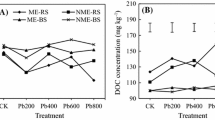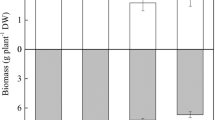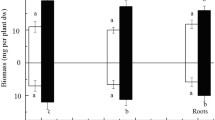Abstract
Better understanding of microbial activity in the rhizosphere soils associated with lead (Pb) uptake by plants may help with the phytoremediation of Pb-contaminated soils. In this work, the effects of Pb exposure (0, 200, 400, 600, 800 mg kg−1) on Pb accumulation and soil microbial activity in the rhizosphere of the mining ecotype (ME) and corresponding non-mining ecotype (NME) of Athyrium wardii (Hook.) Makino were investigated through a pot experiment. Although the plant growth of the two ecotypes was inhibited under Pb stress, the ME showed a less biomass decrease (12.6–44.0%) for aboveground than the NME, showing a greater tolerance to Pb stress. Pb concentrations as well as Pb accumulation in the two ecotypes showed an increasing trend with increasing soil Pb concentrations. The ME presented greater Pb accumulation ability than the NME, especially in underground parts. Pb availability in the rhizosphere soils of the two ecotypes after harvest decreased compared with those before transplantation. Available Pb in the rhizosphere of the ME was 1.4–4.8 times higher than that of the NME under exposure to 200–800 mg kg−1 Pb. The ME shows a greater ability to mobilize Pb in the rhizosphere soils. Pb exposure resulted in an inhibition of microbial activity in the rhizosphere of the two ecotypes. The ME demonstrated greater soil respiration and microbial biomass carbon (MBC) in the rhizosphere than the NME when treated with 200–800 mg kg−1 Pb. The ME showed a less decrease for MBC and a less increase for metabolic quotient in the rhizosphere soils than the NME when exposed to Pb generally. Microorganisms in the rhizosphere soils of the ME seem to be much more adapted to Pb stress, thus showing a great benefit for Pb accumulation and the phytostabilization of Pb-contaminated soils by the ME.






Similar content being viewed by others
References
Ali H, Khan E, Sajad MA (2013) Phytoremediation of heavy metals-concepts and applications. Chemosphere 91(7):869–881
Alvarenga P, Gonçalves AP, Fernandes RM, De Varennes A, Vallini G, Duarte E, Cunha-Queda AC (2009) Organic residues as immobilizing agents in aided phytostabilization:(I) Effects on soil chemical characteristics. Chemosphere 74(10):1292–1300
Andra SS, Datta R, Sarkar D, Makris KC, Mullens CP, Sahi SV, Bach SB (2010) Synthesis of phytochelatins in vetiver grass upon lead exposure in the presence of phosphorus. Plant Soil 326(1–2):171–185
Bolan NS, Park JH, Robinson B, Naidu R, Huh KY (2011) Phytostabilization: a green approach to contaminant containment. In: Advances in agronomy. Academic, Cambridge, pp 145–204
Ciarkowska K, Hanus-Fajerska E, Gambuś F, Muszyńska E, Czech T (2017) Phytostabilization of Zn-Pb ore flotation tailings with Dianthus carthusianorum and Biscutella laevigata after amending with mineral fertilizers or sewage sludge. J Environ Manag 189:75–83
Curl EA, Truelove B (1986) The rhizosphere. Springer, Berlin, pp 1–251
Dary M, Chamber-Pérez MA, Palomares AJ, Pajuelo E (2010) “In situ” phytostabilisation of heavy metal polluted soils using Lupinus luteus inoculated with metal resistant plant-growth promoting rhizobacteria. J Hazard Mater 177(1–3):323–330
Das S, Chou ML, Jean JS, Yang HJ, Kim PJ (2017) Arsenic-enrichment enhanced root exudates and altered rhizosphere microbial communities and activities in hyperaccumulator Pteris. J Hazard Mater 325:279–287
Deng S, Ke T, Li LT, Cai SW, Zhou YY, Liu Y, Guo LM, Chen LZ, Zhang DY (2017) Impacts of environmental factors on the whole microbial communities in the rhizosphere of a metal-tolerant plant, Elsholtzia haichowensis Sun. Environ Pollut 237:1088–1097
Doronila AI, Maddox LE, Reichman SM, King DJ, Kolev SD, Woodrow IE (2014) Vegetation response of Australian native grass species red grass (Bothriochloa macra (Steudel) ST Blake) and spider grass (Enteropogon acicularis (Lindl.) Lazarides) in saline and arsenic contaminated gold mine tailings: a glasshouse study. Miner Eng 56:61–69
Ettler V, Mihaljevic M, Sebek O, Grygar T (2007) Assessment of single extractions for the determination of mobile forms of metals in highly polluted soils and sediments-analytical and thermodynamic approaches. Anal Chim Acta 602:131–140
Evangelou MW, Bauer U, Ebel M, Schaeffer A (2007) The influence of EDDS and EDTA on the uptake of heavy metals of Cd and Cu from soil with tobacco Nicotiana tabacum. Chemosphere 68(2):345–353
Fliessbach A, Martens R, Reber HH (1994) Soil microbial biomass and microbial activity in soils treated with heavy metal contaminated sewage sludge. Soil Biol Biochem 26(9):1201–1205
Gonzaga MIS, Ma LQ, Santos JAG, Matias MIS (2009) Rhizosphere characteristics of two arsenic hyperaccumulating Pteris ferns. Sci Total Environ 407(16):4711–4716
Guarino C, Sciarrillo R (2017) Effectiveness of in situ application of an Integrated Phytoremediation System (IPS) by adding a selected blend of rhizosphere microbes to heavily multi-contaminated soils. Ecol Eng 99:70–82
Gupta DK, Huang HG, Yang XE, Razafindrabe BHN, Inouhe M (2010) The detoxification of lead in Sedum alfredii H. is not related to phytochelatins but the glutathione. J Hazard Mater 177(1–3):437–444
Hu R, Sun K, Su X, Pan YX, Zhang YF, Wang XP (2012) Physiological responses and tolerance mechanisms to Pb in two xerophils, Salsola passerina Bunge and Chenopodium album L. J Hazard Mater 205:131–138
Kim S, Kang H (2011) Effects of elevated CO2 and Pb on phytoextraction and enzyme activity. Water Air Soil Pollut 219(1–4):365–375
Lee SH, Ji W, Lee WS, Koo N, Koh IH, Kim MS, Park JS (2014) Influence of amendments and aided phytostabilization on metal availability and mobility in Pb/Zn mine tailings. J Environ Manag 139:15–21
Li YL, Liu YG, Liu JL, Zeng GM, Li X (2008) Effects of EDTA on lead uptake by Typha orientalis Presl, a new lead-accumulating species in southern China. Bull Environ Contam Toxicol 81(1):36–41
Li TQ, Di ZZ, Islam E, Jiang H, Yang XE (2011) Rhizosphere characteristics of zinc hyperaccumulator Sedum alfredii involved in zinc accumulation. J Hazard Mater 185(2–3):818–823
Li TQ, Tao Q, Han X, Yang XE (2013a) Effects of elevated CO2 on rhizosphere characteristics of Cd/Zn hyperaccumulator Sedum alfredii. Sci Total Environ 454:510–516
Li TQ, Liang CF, Han X, Yang XE (2013b) Mobilization of cadmium by dissolved organic matter in the rhizosphere of hyperaccumulator Sedum alfredii. Chemosphere 91(7):970–976
Lu RK (1999) Analysis of soil agrochemistry. Chinese Agricultural Science and Technology Press, Beijing, pp 1–246 (in Chinese)
Lu M, Xu K, Chen J (2013) Effect of pyrene and cadmium on microbial activity and community structure in soil. Chemosphere 91(4):491–497
Luster J, Göttlein A, Nowack B, Sarret G (2009) Sampling, defining, characterising and modelling the rhizosphere - the soils science toolbox. Plant Soil 321:457–482
Ma Y, Prasad MNV, Rajkumar M, Freitas H (2011) Plant growth promoting rhizobacteria and endophytes accelerate phytoremediation of metalliferous soils. Biotechnol Adv 29(2):248–258
Mahar A, Wang P, Ali A, Awasthi MK, Lahori AH, Wang Q, Li RH, Zhang ZQ (2016) Challenges and opportunities in the phytoremediation of heavy metals contaminated soils: a review. Ecotoxicol Environ Saf 126:111–121
Maiz I, Arambarri I, Garcia R, Millan E (2000) Evaluation of heavy metal availability in polluted soils by two sequential extraction procedures using factor analysis. Environ Pollut 110:3–9
Mani D, Kumar C (2014) Biotechnological advances in bioremediation of heavy metals contaminated ecosystems, an overview with special reference to phytoremediation. Int J Environ Sci Technol 11(3):843–872
Masciandaro G, Macci C, Peruzzi E, Ceccanti B, Doni S (2013) Organic matter–microorganism–plant in soil bioremediation, a synergic approach. Rev Environ Sci Biotechnol 12(4):399–419
Meeinkuirt W, Kruatrachue M, Tanhan P, Chaiyarat R, Pokethitiyook P (2013) Phytostabilization potential of Pb mine tailings by two grass species, Thysanolaena maxima and Vetiveria zizanioides. Water Air Soil Pollut 224(10):1750
Meier S, Borie F, Bolan N, Cornejo P (2012) Phytoremediation of metal-polluted soils by arbuscular mycorrhizal fungi. Crit Rev Environ Sci Technol 42(7):741–775
Mendez MO, Maier RM (2008) Phytostabilization of mine tailings in arid and semiarid environments-an emerging remediation technology. Environ Health Perspect 116(3):278–283
Moyé J, Picard-Lesteven T, Zouhri L, El Amari K, Hibti M, Benkaddour A (2017) Groundwater assessment and environmental impact in the abandoned mine of Kettara (Morocco). Environ Pollut 231:899–907
Muszyńska E, Mateusz L, Różańska E, Hanus-Fajerska E, Znojek E (2018) Heavy metal tolerance in contrasting ecotypes of Alyssum montanum. Ecotoxicol Environ Saf 161:305–317
Parelho C, Rodrigues AS, Barreto MC, Ferreira NGC, Garcia P (2016) Assessing microbial activities in metal contaminated agricultural volcanic soils - an integrative approach. Ecotoxicol Environ Saf 129:242–249
Park JH, Lamb D, Paneerselvam P, Choppala G, Bolan N, Chung JW (2011) Role of organic amendments on enhanced bioremediation of heavy metal (loid) contaminated soils. J Hazard Mater 185(2–3):549–574
Rajkumar M, Sandhya S, Prasad MNV, Freitas H (2012) Perspectives of plant-associated microbes in heavy metal phytoremediation. Biotechnol Adv 30(6):1562–1574
Shakoor MB, Ali S, Farid M, Farooq MA, Tauqeer HM, Iftikhar U, Hannan F, Bharwana SA (2013) Heavy metal pollution, a global problem and its remediation by chemically enhanced phytoremediation, a review. J Biol Environ Sci 3:12–20
Shu XH, Zhang Q, Lu GN, Yi XY, Dang Z (2017) Pollution characteristics and assessment of sulfide tailings from the Dabaoshan Mine, China. Int Biodeterior Biodegradation 128:122–128
Silva EFD, Durães N, Reis P, Patinha C, Matos J, Costa MR (2015) An integrative assessment of environmental degradation of Caveira abandoned mine area (Southern Portugal). J Geochem Explor 159:33–47
Singh R, Tripathi RD, Dwivedi S, Kumar A, Trivedi PK, Chakrabarty D (2010) Lead bioaccumulation potential of an aquatic macrophyte Najas indica are related to antioxidant system. Bioresour Technol 101(9):3025–3032
Tripathy S, Bhattacharyya P, Mohapatra R, Som A, Chowdhury D (2014) Influence of different fractions of heavy metals on microbial ecophysiological indicators and enzyme activities in century old municipal solid waste amended soil. Ecol Eng 70:25–34
Vance ED, Brookes PC, Jenkinson DS (1987) An extraction method for measuring soil microbial biomass C. Soil Biol Biochem 19(6):703–707
Wang YP, Li QB, Shi JY, Lin Q, Chen XC, Wu WX, Chen YX (2008) Assessment of microbial activity and bacterial community composition in the rhizosphere of a copper accumulator and a non-accumulator. Soil Biol Biochem 40:1167–1177
Wei S, Twardowska I (2013) Main rhizosphere characteristics of the Cd hyperaccumulator Rorippa globosa (Turcz.) Thell. Plant Soil 372(1–2):669–681
Wenzel WW (2009) Rhizosphere processes and management in plant-assisted bioremediation (phytoremediation) of soils. Plant Soil 321:385–408
Wójcik M, Tukiendorf A (2014) Accumulation and tolerance of lead in two contrasting ecotypes of Dianthus carthusianorum. Phytochemistry 100:60–65
Yang B, Zhou M, Zhou LL, Xue ND, Zhang SL, Lan CY (2015) Variability of cadmium, lead, and zinc tolerance and accumulation among and between germplasms of the fiber crop Boehmeria nivea with different root-types. Environ Sci Pollut Res 22(18):13960–13969
Zhan J, Li TX, Yu HY, Zhang XZ, Zhao L (2016) The influence of humic substance on Cd accumulation of phytostabilizer Athyrium wardii (Hook.) grown in Cd-contaminated soils. Environ Sci Pollut Res 23(18):18524–18532
Zhan J, Li TX, Zhang XZ, Yu HY, Zhao L (2018) Rhizosphere characteristics of phytostabilizer Athyrium wardii (Hook.) involved in Cd and Pb accumulation. Ecotoxicol Environ Saf 148:892–900
Zhang SJ, Li TX, Huang HG, Zou TJ, Zhang XZ, Yu HY, Zheng ZC, Wang YD (2012) Cd accumulation and phytostabilization potential of dominant plants surrounding mining tailings. Environ Sci Pollut Res 19(9):3879–3888
Zhang SJ, Li TX, Zhang XZ, Yu HY, Zheng ZC, Wang YD, Hao XQ, Pu Y (2014) Changes in pH, dissolved organic matter and Cd species in the rhizosphere soils of Cd phytostabilizer Athyrium wardii (Hook.) Makino involved in Cd tolerance and accumulation. Environ Sci Pollut Res 21:4605–4613
Zhao L, Li TX, Yu HY, Chen GD, Zhang XZ, Zheng ZC, Li JX (2015) Changes in chemical forms, subcellular distribution, and thiol compounds involved in Pb accumulation and detoxification in Athyrium wardii (Hook.). Environ Sci Pollut Res 22(16):12676–12688
Zhao L, Li TX, Zhang XZ, Chen GD, Zheng ZC, Yu HY (2016a) Pb uptake and phytostabilization potential of the mining ecotype of Athyrium wardii (Hook.) grown in Pb-contaminated Soil. Clean Soil Air Water 44(9):1184–1190
Zhao L, Li TX, Zhang XZ, Chen GD, Zheng ZC, Yu HY (2016b) Rhizosphere characteristics of Pb phytostabilizer Athyrium wardii (Hook.) involved in Pb accumulation. Environ Earth Sci 75(6):463
Zhou HM, Zhang DX, Wang P, Liu XY, Cheng K, Li LQ, Zheng JW, Zhang XH, Zheng JF, Crowley G, Zwieten L, Pan G (2017) Changes in microbial biomass and metabolic quotient with biochar addition to agricultural soils: a meta-analysis. Agric Ecosyst Environ 239:80–89
Zhu GX, Xiao HY, Guo QJ, Song B, Zheng GD, Zhang ZY, Zhao JJ, Okoli CP (2018) Heavy metal contents and enrichment characteristics of dominant plants in wasteland of the downstream of a lead-zinc mining area in Guangxi, Southwest China. Ecotoxicol Environ Saf 151:266–271
Zou TJ, Li TX, Zhang XZ, Yu HY, Luo HB (2011) Lead accumulation and tolerance characteristics of Athyrium wardii (Hook.) as a potential phytostabilizer. J Hazard Mater 186(1):683–689
Zou TJ, Li TX, Zhang XZ, Yu HY, Huang HG (2012) Lead accumulation and phytostabilization potential of dominant plant species growing in a lead–zinc mine tailing. Environ Earth Sci 65(3):621–630
Funding
This study was financially supported by the National Key Research and Development Program (2018YFD0800600) and Sichuan Key Research Programs (2017SZ0188, 2017SZ0198, and 2018SZ0326).
Author information
Authors and Affiliations
Corresponding author
Additional information
Responsible editor: Elena Maestri
Publisher’s note
Springer Nature remains neutral with regard to jurisdictional claims in published maps and institutional affiliations.
Qingpei Zhang and Juan Zhan are the co-first authors.
Electronic supplementary material
ESM 1
(DOC 60 kb)
Rights and permissions
About this article
Cite this article
Zhang, Q., Zhan, J., Yu, H. et al. Lead accumulation and soil microbial activity in the rhizosphere of the mining and non-mining ecotypes of Athyrium wardii (Hook.) Makino in adaptation to lead-contaminated soils. Environ Sci Pollut Res 26, 32957–32966 (2019). https://doi.org/10.1007/s11356-019-06395-1
Received:
Accepted:
Published:
Issue Date:
DOI: https://doi.org/10.1007/s11356-019-06395-1




